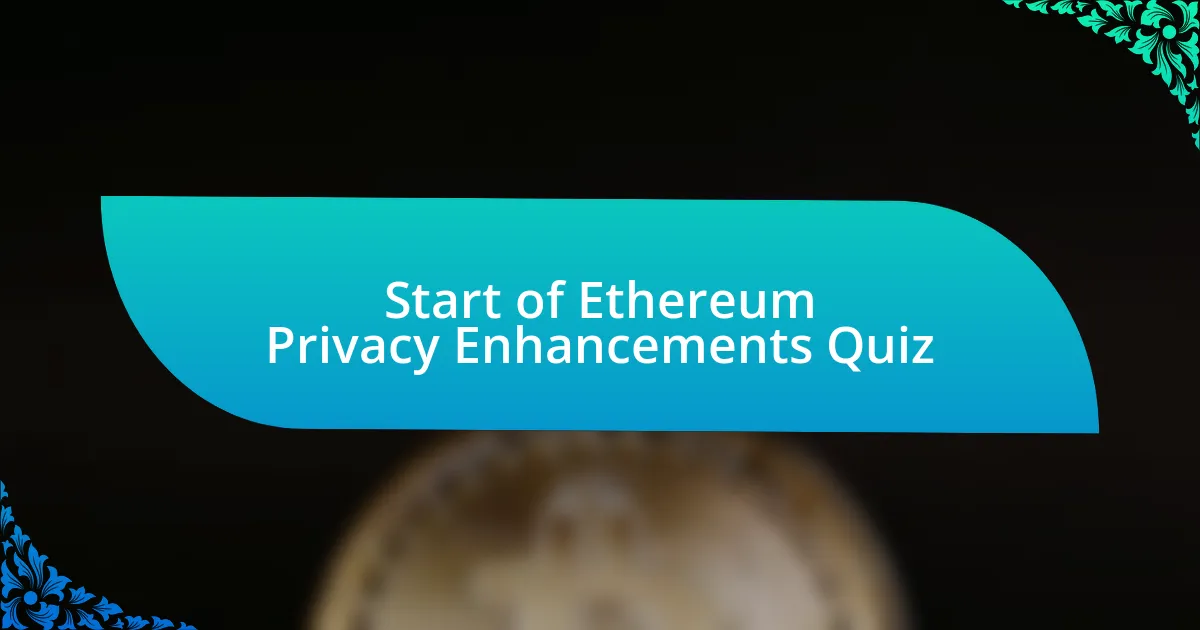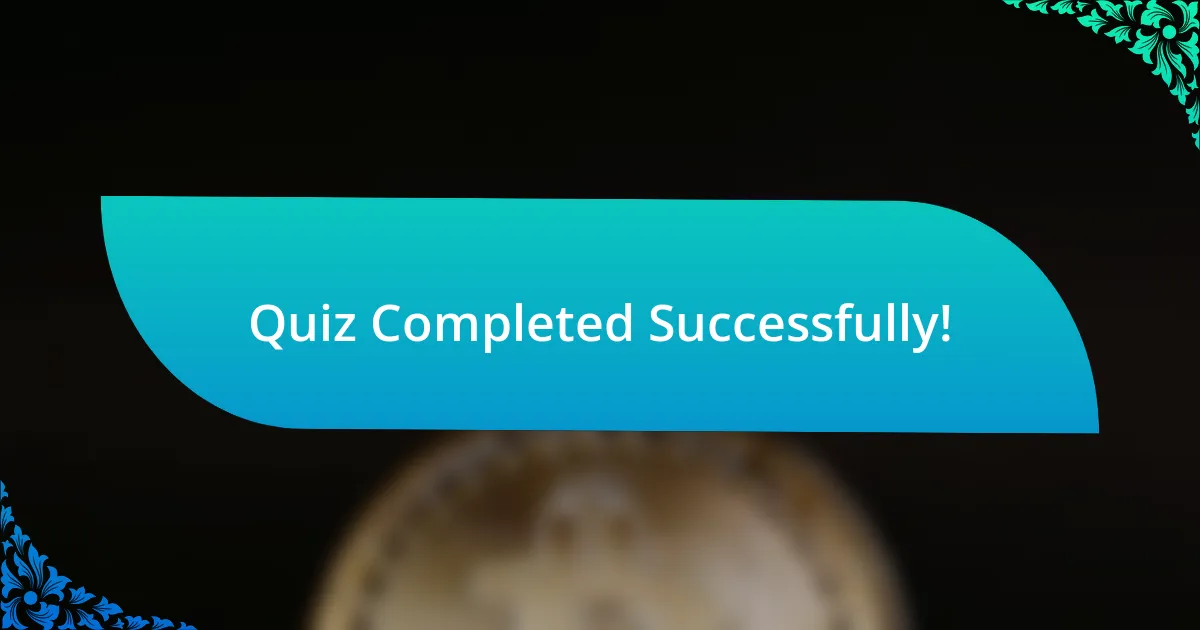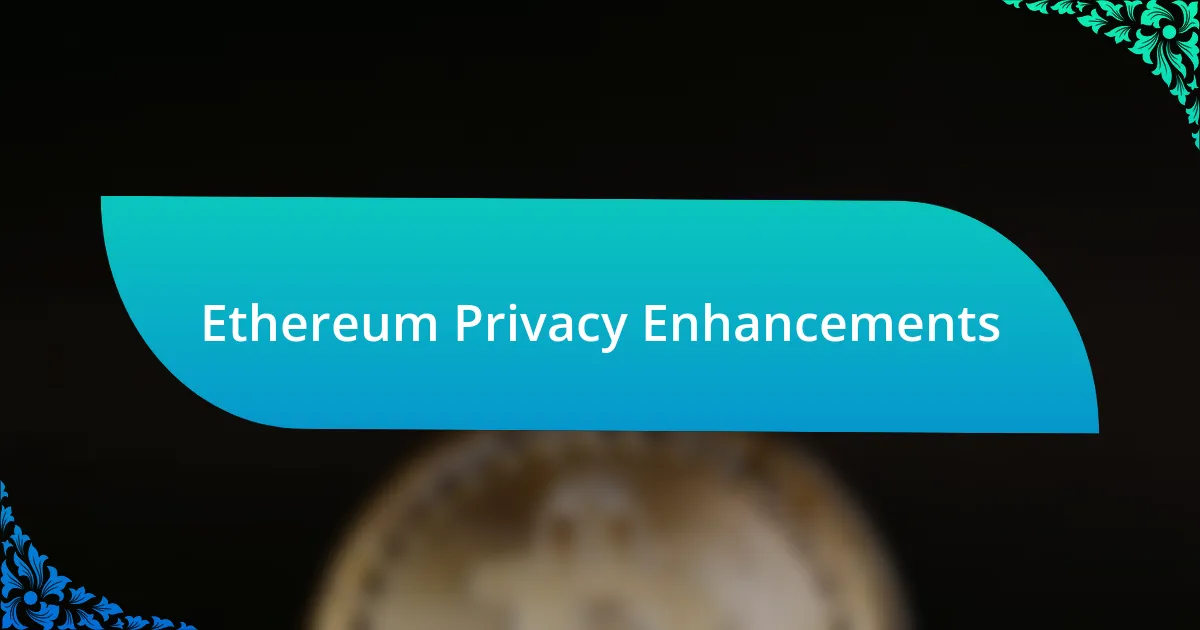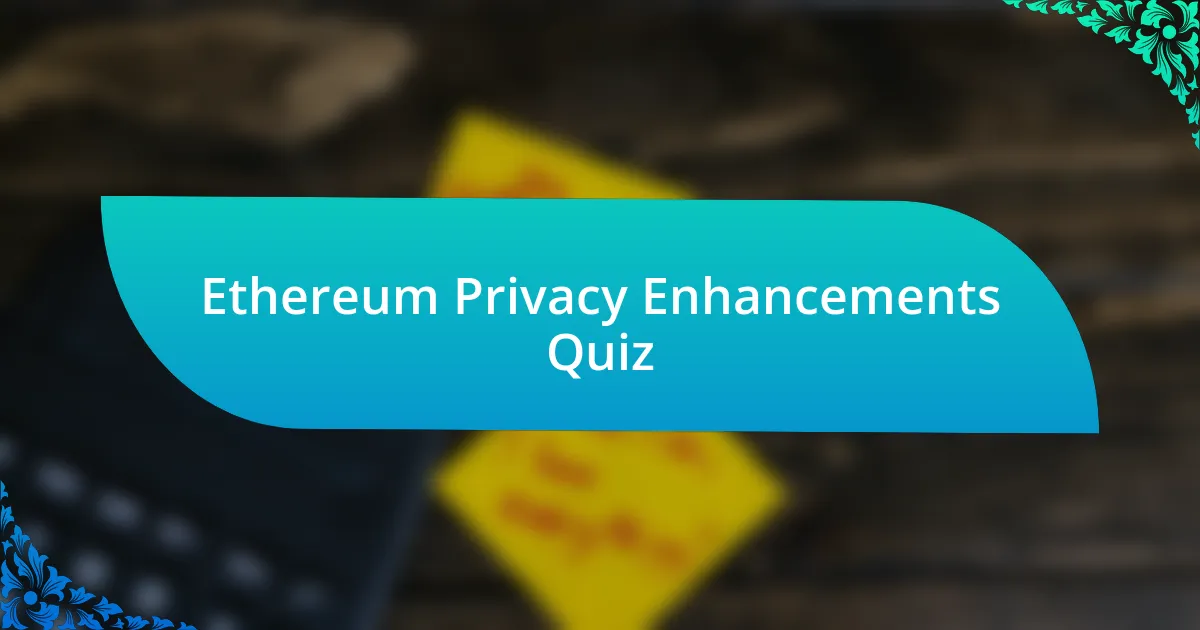
Start of Ethereum Privacy Enhancements Quiz
1. What is the primary focus of Ethereum`s latest roadmap release, `The Splurge`?
- Increasing transaction fees to improve miner incentives.
- Incorporating more proof-of-work features to enhance decentralization.
- User interface redesign for better accessibility.
- Protocol optimizations essential for network efficiency and long-term security.
2. What are the planned improvements to Ethereum`s EVM aimed at?
- Enabling instant withdrawals for all staked Ether holders.
- Improving efficiency, supporting advanced cryptographic functions without extensive precompiles.
- Reducing the transaction fees for all users on the network.
- Enhancing the graphics processing of mining operations significantly.
3. What is the purpose of the new EVM Object Format (EOF)?
- To enhance the user interface of Ethereum wallets.
- To increase transaction fees and improve revenue for miners.
- To separate code from data, prohibit dynamic jumps, and add a specific subroutine mechanism.
- To simplify the programming languages used for smart contracts.
4. What are Modular Arithmetic Extensions (EVM-MAX) used for?
- To facilitate real-time transaction monitoring and reporting on the blockchain.
- To enhance the user interface and experience of the Ethereum blockchain.
- To create a secure space within the EVM for optimized cryptographic functions.
- To improve the speed of consensus algorithms used in Ethereum.
5. How do zero-knowledge proofs work?
- They allow multiple parties to verify a statement`s truth without revealing information beyond the statement`s validity or falsity.
- They enable complete information sharing among all participants in a transaction.
- They require parties to disclose all their private information during verification.
- They rely on shared knowledge between parties to establish trust.
6. What is completeness in zero-knowledge proofs?
- If a statement is true, an honest prover should easily be able to convince a verifier of this.
- An honest prover can only convince a verifier of false statements.
- The verifier must independently verify everything without the prover`s help.
- If a statement is false, it should be easy for a prover to deceive the verifier.
7. What is soundness in zero-knowledge proofs?
- If a statement is false, a dishonest prover can still demonstrate its validity.
- If a statement is true, no verifier can challenge or reject it.
- If a statement is false, a dishonest prover should not be able to trick a verifier.
- If a statement is true, a dishonest prover should easily convince a verifier.
8. What is zero-knowledge in zero-knowledge proofs?
- Only one party can verify the statement fully.
- Neither party can extract additional private information.
- Both parties reveal all information exchanged.
- Information is encrypted but shared openly.
9. What are zk-SNARKs used for in Ethereum?
- To prove possession of certain information without revealing its details.
- To create new tokens and manage assets on the blockchain.
- To enhance network stability by increasing block sizes.
- To verify transaction speeds without compromising security.
10. What are zk-STARKs used for in Ethereum?
- To replace the entire Ethereum blockchain with a new one.
- To scale large computations while maintaining transparency and scalability.
- To create non-fungible tokens exclusively on Ethereum.
- To encrypt all transactions on the Ethereum network for security.
11. What is account abstraction in Ethereum?
- It redefines Ether’s transaction system by enabling smart contracts to initiate transactions instead of externally owned accounts.
- It employs centralized controls for transaction validation within the Ethereum network.
- It allows users to transfer Ether directly to any account without gas fees.
- It restricts transactions solely to external owned accounts for security purposes.
12. What are the benefits of account abstraction in Ethereum?
- Increased block size and higher transaction throughput, enabling faster confirmations.
- Enhanced data storage capabilities and unlimited transaction history for every user.
- Simplified transaction speeds and lower gas fees, offering better access to everyone.
- Advanced security and improved user experience, allowing accounts to pay transaction fees using other tokens and adopting quantum-resistant cryptography.
13. What is Verifiable Delay Function (VDF) in Ethereum?
- A cryptographic technique that ensures computations are performed at a predictable rate, useful for maintaining network security.
- A feature that allows any user to create smart contracts easily.
- A tool for creating unlimited Ethereum addresses securely.
- A method for instant transaction verification in the Ethereum network.
14. How do zero-knowledge rollups and validiums improve Ethereum’s scalability?
- They enforce strict data availability requirements that slow down transaction processing.
- They execute thousands of transactions off-chain and submit proofs for verification on Ethereum, allowing immediate application of results without increasing computation on the base layer.
- They rely solely on increasing the gas limits per transaction to improve throughput.
- They require all transactions to occur on-chain, ensuring full transparency for every action.
15. What is the role of zero-knowledge proofs in maintaining blockchain security?
- They ensure that transactions are valid without revealing any underlying data, thus maintaining transparency and security.
- They serve to increase transaction speeds by decreasing verification times.
- They allow complete data access for all parties to verify information integrity.
- They require full disclosure of transaction details for network confirmations.
16. What is the difference between on-chain and off-chain scaling solutions for Ethereum?
- On-chain solutions allow for faster transactions, while off-chain solutions depend on centralized servers.
- Off-chain solutions run on the main blockchain, while on-chain solutions utilize external networks.
- Off-chain solutions require layer modifications, while on-chain solutions operate independently.
- On-chain solutions modify the base layer, while off-chain solutions execute transactions externally and verify proofs.
17. How do mixing services like Tornado Cash enhance privacy in Ethereum?
- They increase transaction fees to enhance security on the network.
- They store transaction details on a public ledger for transparency.
- They require users to provide personal information for transaction approval.
- They shuffle transactions with others, making it challenging to trace their origins and destinations, thus anonymizing transactions.
18. What is the significance of transparency and privacy in Ethereum?
- Transparency and privacy undermine each other in the Ethereum network.
- Both are crucial for maintaining trust in the network; transparency ensures accountability, while privacy protects user data.
- Transparency safeguards data integrity, while privacy is solely for user anonymity.
- Transparency is important for network accountability, while privacy is irrelevant.
19. How do layer-2 solutions like zkSync and Polygon enhance privacy in Ethereum?
- They increase transaction fees by adding more complexity to the main chain`s operations.
- They provide scalability and privacy enhancements by processing transactions off the main chain, thus reducing the load on the main network and improving user privacy.
- They require users to submit their private keys for enhanced verification on the main chain.
- They rely on centralized databases to store user information for easier access.
20. What is the purpose of using cryptographic hash functions in zero-knowledge proofs?
- To generate random challenges for verifiers as they work toward developing mutual trust with provers.
- To create digital signatures for transactions and contracts.
- To store sensitive information in an unbreakable format.
- To encode personal data securely during transmissions.
21. How do zero-knowledge proofs ensure users` data remains private during transactions?
- They allow multiple parties to verify a statement`s truth without revealing information beyond the statement`s validity or falsity.
- They generate irreversible changes to user data in the blockchain ledger.
- They ensure all transaction data is public and accessible to everyone involved.
- They require users to disclose their personal information for verification during transactions.
22. What role do zero-knowledge rollups play in Ethereum`s privacy enhancements?
- They integrate all transaction data into a single block for easier management.
- They separate transactions into smaller segments to improve speed and efficiency.
- They encrypt all smart contracts to prevent unauthorized access by third parties.
- They enhance privacy by allowing validation of transactions without revealing underlying data.
23. How do zk-SNARKs contribute to the Ethereum ecosystem`s privacy features?
- They allow users to publicly disclose all transaction details for transparency.
- They simplify smart contracts by eliminating the need for complex cryptographic algorithms.
- They increase transaction fees by requiring additional computation for verification.
- They enable privacy-preserving smart contracts by proving information possession without revealing details.
24. What is the relationship between account abstraction and enhanced security in Ethereum?
- Account abstraction allows for enhanced security through the use of smart contracts to manage transactions.
- Account abstraction reduces the complexity of transaction data only.
- Account abstraction simplifies user interfaces for wallet applications exclusively.
- Account abstraction is primarily focused on improving gas fees in the Ethereum network.
25. How does the introduction of EOF affect smart contract development in Ethereum?
- It separates code from data within smart contracts for efficiency.
- It restricts all transactions to only static data inputs.
- It eliminates the need for blockchain validation completely.
- It reduces the maximum number of transactions per block.
26. What implications do VDFs have for the overall security of the Ethereum network?
- Simplified programming for smart contracts.
- Increased block size limitations on Ethereum.
- Improved network security and attack prevention.
- Decreased transaction speed and efficiency.
27. How do zk-STARKs maintain transparency while enhancing scalability?
- They rely on traditional encryption techniques to manage data security and reduce transaction times.
- They improve performance by eliminating the need for consensus among all nodes in the network.
- They enhance scalability by increasing the block size and lowering the transaction fees for users.
- They utilize proof systems to execute computations efficiently while safeguarding data privacy.
28. What technologies underlie the mixer`s operations in enhancing Ethereum`s transaction privacy?
- Modular arithmetic extensions
- Cryptographic hash functions
- Verifiable delay functions
- Zero-knowledge proofs
29. What are the security benefits foreseen with zk-rollups in Ethereum`s framework?
- Simplified smart contract coding requirements.
- Enhanced transaction privacy and data protection.
- Increased transaction fees and network congestion.
- Faster transaction speeds without verification.
30. How do cryptographic hash functions aid in the generation of challenges in zero-knowledge proofs?
- To encrypt sensitive data during transmission.
- To create signatures for transactions on the blockchain.
- To generate public and private keys for users.
- To generate random challenges for verifiers as they work toward developing mutual trust with provers.

Quiz Completed Successfully!
Congratulations on finishing the quiz on Ethereum Privacy Enhancements! This achievement reflects your commitment to understanding the intricacies of privacy in the Ethereum ecosystem. Through this quiz, you have likely uncovered various mechanisms aimed at improving anonymity and security on the platform, as well as the challenges and implications of using these enhancements.
Many learners discover the importance of privacy in blockchain technology. You may have gained insights into how Ethereum’s privacy solutions, such as zk-SNARKs and mixing services, can enhance user confidentiality. Understanding these features helps you appreciate the delicate balance between transparency and privacy within the Ethereum network.
We encourage you to delve deeper into this fascinating topic. Check out the next section on this page for more detailed information about Ethereum Privacy Enhancements. Expanding your knowledge in this area will empower you to make informed decisions and engage with the Ethereum community more effectively. Enjoy your exploration!

Ethereum Privacy Enhancements
Introduction to Ethereum Privacy Enhancements
Ethereum privacy enhancements refer to technologies and protocols designed to improve the privacy of transactions and user data on the Ethereum blockchain. Given Ethereum’s transparent nature, where all transaction details are publicly visible, privacy enhancements are critical for users requiring confidentiality. Solutions like zero-knowledge proofs and mixing services have emerged to obscure transaction details while maintaining network security and functionality.
Zero-Knowledge Proofs in Ethereum
Zero-knowledge proofs (ZKPs) are cryptographic methods that allow a party to prove knowledge of a secret without revealing the secret itself. In Ethereum, ZKPs help enhance privacy by enabling users to prove their transactions are valid without disclosing specific amounts or addresses involved. Projects such as zk-SNARKs and zk-STARKs integrate ZKPs into Ethereum, allowing for secure, private transactions while ensuring compliance with network validators.
Use of Mixing Services for Anonymity
Mixing services enhance Ethereum’s privacy by combining multiple users’ transactions, which obfuscates the transaction source and destination. This process makes it challenging to trace individual transactions back to their origin. Services like Tornado Cash help users achieve transactional anonymity on Ethereum by pooling funds and redistributing them, thereby complicating the link between sender and receiver.
Layer 2 Solutions and Privacy Features
Layer 2 solutions, such as Optimistic Rollups and zk-Rollups, aim to improve transaction speed and scalability on Ethereum while incorporating privacy features. These solutions enable off-chain transactions, reducing on-chain data exposure. By aggregating multiple transactions, they enhance user privacy while still benefiting from Ethereum’s security, allowing for efficient and confidential trading or asset transfers.
Future Prospects of Privacy on Ethereum
The future of privacy on Ethereum will likely include ongoing developments in cryptographic techniques and layer 2 innovations. The Ethereum community continuously explores enhancing privacy through proposals, upgrades, and research initiatives. As regulatory scrutiny increases, robust privacy measures may become necessary to protect users’ financial data and ensure compliance with privacy regulations without sacrificing the accountability of blockchain technology.
What are Ethereum Privacy Enhancements?
Ethereum Privacy Enhancements are methods and technologies designed to increase user privacy and transaction confidentiality on the Ethereum blockchain. These enhancements include solutions like zk-SNARKs, which allow for private transactions without revealing the sender, receiver, or transaction amount on the public ledger. Additionally, projects such as Tornado Cash enable users to achieve greater anonymity by breaking the on-chain link between the sender and recipient through methods of mixing transactions.
How do Ethereum Privacy Enhancements work?
Ethereum Privacy Enhancements work primarily through cryptographic techniques that obscure transaction details. For example, zk-SNARKs use zero-knowledge proofs to confirm a transaction’s validity without revealing any information about the transaction itself. Other methods, like mixing services, pool multiple transactions together, making it difficult to trace the flow of funds. By employing these techniques, users can conduct transactions on Ethereum with enhanced privacy.
Where can Ethereum Privacy Enhancements be implemented?
Ethereum Privacy Enhancements can be implemented in decentralized applications (dApps), smart contracts, and various token transactions on the Ethereum network. Many projects integrating privacy features utilize smart contracts that harness zk-SNARKs or similar technologies to facilitate private interactions. These enhancements can be particularly useful in areas such as decentralized finance (DeFi), where anonymity can be crucial for users.
When were Ethereum Privacy Enhancements introduced?
Ethereum Privacy Enhancements began to gain traction with the introduction of zk-SNARKs in late 2016 and the launch of private transaction mixers like Tornado Cash in 2020. This timing coincided with increasing concerns about privacy and surveillance in blockchain transactions, leading to the development and adoption of these technologies to address such needs.
Who developed Ethereum Privacy Enhancements?
Ethereum Privacy Enhancements have been developed by a variety of contributors, including researchers, developers, and organizations within the Ethereum community. Notable projects, such as Zcash, introduced zk-SNARKs—an early implementation that inspired further development of similar privacy features on Ethereum. Organizations like the Electronic Frontier Foundation (EFF) also advocate for and contribute to privacy-focused solutions in the blockchain space.

